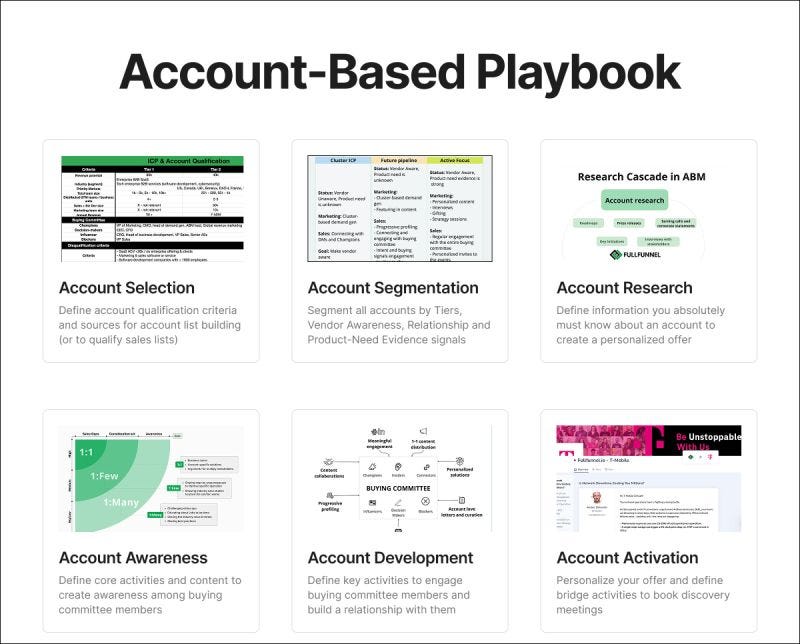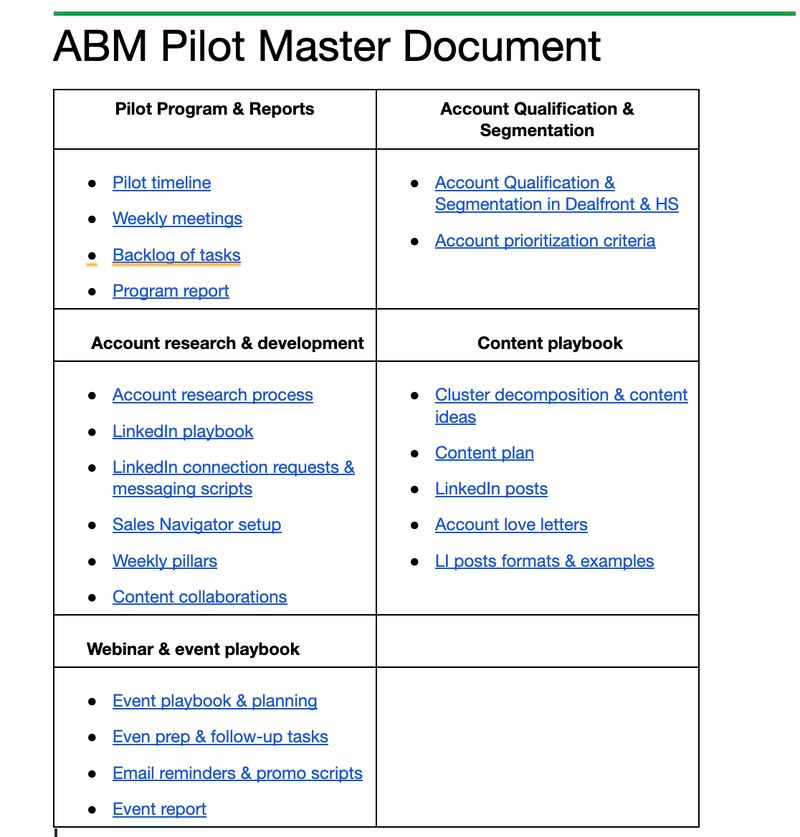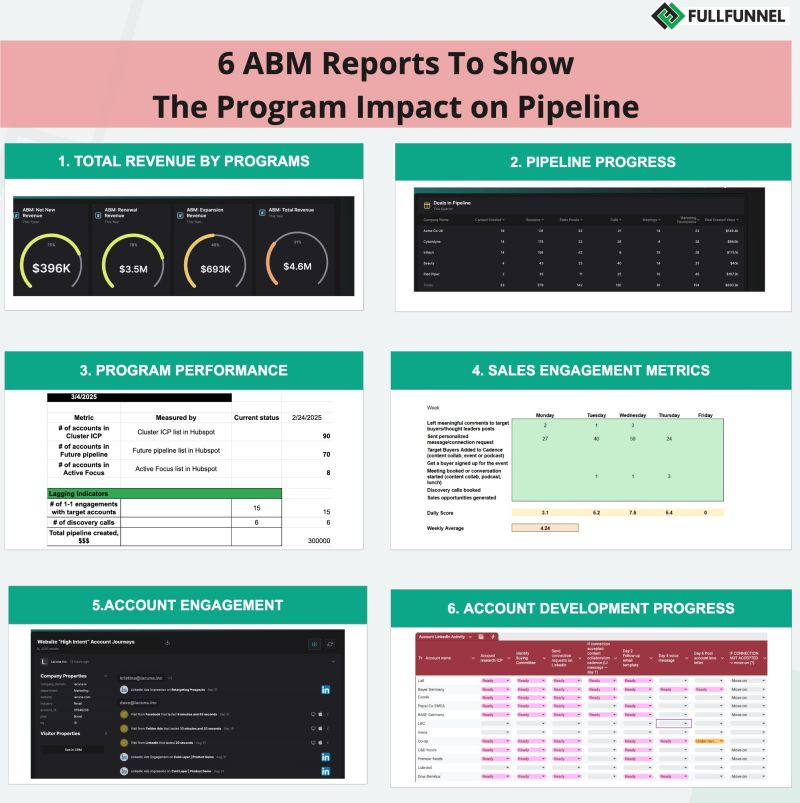The real truth why most B2B companies can’t make ABM work and later scale it is lack of strong documentation and orchestration. The scaling efforts often could be described as “here is our stack, here are the ads and the creatives, here is the messaging - go and replicate it”.
The problem?
There is no proven process the teams can take to replicate the success.
In today’s newsletter, we cover:
The architecture of an ABM playbook.
How to operationalize ABM and measure program efficiency.
How to run a successful ABM program [roundtable with 4 B2B CMOs]
BECOME A FULL-FUNNEL B2B MARKETER
Full-Funnel Academy is a comprehensive B2B marketing training and Slack community for B2B marketers who care about revenue and want to move the needle.
Academy includes:
All our B2B marketing courses including ABM playbook, Demand Gen Playbook, LinkedIn Allbound marketing playbook and 11 more courses that aren't available publicly + all upcoming courses.
Private Slack community to answer all your questions
Personalized learning plan. If you are not sure what skills you’d develop in the first place and how to get maximum from the program, we can create a personalized learning plan accordingly to the time you can dedicate to education.
Behind the scenes sessions. See what’s working and what doesn’t work and why on the “behind the scenes” sessions where we review the campaigns we are running for our clients and us.
30% discount for live events and bootcamps
Learn more and join the academy here.
The architecture of an ABM playbook.
There is a common misconception that an ABM playbook is all about tracking signals that demonstrate buying intent, personalizing your message, and reaching out to the buyers.
First, the only signal that demonstrates buying intent is when your prospect asks to send an invoice. 😁
Second, the personalization in ABM is not the dynamic text based on the signal aka “I saw you raised money / hiring a GTM engineer / ….put your signal”.
Personalization in ABM is a deep research of target account and buying committee member priorities, key initiatives, challenges, and the current stage of the buyer journey.
*Check this post where we cover personalization: https://fullfunnel.substack.com/p/aligning-abm-with-buyer-journey
Third, there is a false assumption that ABM is fully owned by marketing and can be executed in a programmatic 1:many way.
Combine it with the absence of a dedicated ABM team, broad targeting to sales wish lists, a lack of account engagement, and you have a battle proven way to fail thr program.
Here is a 6A framework we use to create an account-based playbook.
Pre-requisites:
Formed ABM team
Defined program goals (new logo, expansion, acceleration)
Defined cluster or vertical
Cluster win/loss deal analysis
Here are 6 playbook pillars.
1. ACCOUNT QUALIFICATION.
- Firmo and technographics
- Qualification criteria / signals
- Disqualification criteria
- Tier segmentation
- Buying committee structure
2. ACCOUNT SEGMENTATION.
Segment all accounts by Tiers, Vendor Awareness, Relationship and Product-Need Evidence signals.
1. Cluster ICP accounts (Not aware of us & product need is unknown).
2. Future Pipeline accounts (Aware of us & product need is unknown).
3. Active Focus accounts (Aware of us and the product need is known).
3. ACCOUNT RESEARCH.
Define information you absolutely must know about an account to create a personalized offer:
- Strategic initiatives and priorities
- Challenges
- Jobs-to-be-done & KPis of target buyer persona
- Other account enrichment information
Split it into desk and 1-1 research.
4. ACCOUNT AWARENESS.
Define core activities and content to create awareness among buying committee members.
5. ACCOUNT DEVELOPMENT.
Define key activities to engage buying committee members and build a relationship with them.
6. ACCOUNT ACTIVATION.
Personalize your offer and define bridge activities to book discovery meetings.
GET ACCESS TO A NEW FULL-FUNNEL ABM 2.0 COURSE
What's included with the course access:
12 modules covering step-by-step ABM strategy development: goal decomposition, ICP, account list building, ABM team, warm-up and activation playbooks, reporting, scaling ABM and building a cohesive ABM & demand gen function.
Short explanation videos and "how to" examples. We believe it's better one time to see a practical example then listen to the theory hundreds of times.
5 orchestrated and ready-to-use ABM playbooks and a detailed explanation
Report dashboard for 4 types of ABM programs: new revenue, pipeline acceleration, expansion and churn prevention
Live case studies and examples of the campaigns we implemented with the clients of Fullfunnel.io in the past few years
17 templates to simplify your ABM strategy launch: ICP, revenue analysis, intent data tracking, account warm-up cadence, customer research, account scoring and prioritization, ABM budget planning and forecasting, account planning, reports, personalized offers, and many more.
Planning & Presenting a Pilot ABM Program to Execs and Sales Framework
Minimal viable stack recommendation and guidelines on how to use it to avoid ramping up budget and being pressured to show ROI for the purchased $50k software
How to operationalize ABM and measure program efficiency.
When you finish working on the ABM playbook pillars, the next step is creating strong documentation.
What's the role of the playbook in the ABM program? The big picture
How should the playbook be executed? A visual overview and detailed step-by-step instruction
What are our best practices and examples? Include screenshots, templates and scripts
Ownership and responsibilities
Program and playbook measurement
The key goal is to create:
internal quality benchmarks (what “the good” looks like)
streamline the key process that the team members should run
understanding of how to measure progress and what metrics are important
efficient planning to avoid random acts of marketing
Next step is to combine all playbooks in a master document.
Here are the key sections you should consider including.
1. PROGRAM OVERVIEW.
Program presentation
Goals
Program report
ABM weekly backlog
2. ACCOUNT QUALIFICATION AND PRIORITIZATION.
The key signals to identify engageed accounts
Account qualification and prioritization criteria
Tracking frequency and ownership (who tracks what and when)
Account sourcing process to CRM
Account card structure to store all the information
3. ACCOUNT RESEARCH AND DEVELOPMENT.
Key sources of account insights. How and where to save them.
Buying committee mapping in Sales Navigator
Standard engagement cadence
Connection requests and scripts collection
Weekly KPIs for ABM SDRs
Playbooks for the 1st party and 3rd party signals
4. ACCOUNT-BASED CONTENT.
Account-based content creation workflow and quality benchmark
Content backlog and plan
Best posts formats and examples
Learn more about account-based content strategy here: https://fullfunnel.io/abm-content/
These 4 core playbooks are usually accompanied by other playbooks included in the ABM program + holistic reports to track the playbook and the entire program efficiency.
I’ll cover them below.
GET ACCESS TO A NEW B2B DEMAND GENERATION PLAYBOOK
You’ll get access to:
25 short and actionable videos and tutorials. No theory or high-level overview
15-mins max videos to explain a specific process or show how to implement it
10 ready-to-use templates including demand gen reports, budgeting demand gen program, creating joint playbooks with sales, a pilot demand generation program presentation, demand generation program examples, thought leadership, nurturing content production templates, and many more
30/60/90 launch plan with step-by-step instructions, demang gen plan example, and a timeline
P.S. If you have access to our ABM course, the new demand generation playbook will help you increase awareness and support your ABM program with engaged strategic accounts.
How to track the efficiency of ABM playbooks
You need to report on revenue from ABM, but it is not always possible in the short-term (especially for the pilot programs).
Here are the reports you can share with your team and leadership to track the entire program and its playbooks efficiency.
1. TOTAL REVENUE BY PROGRAMS AND TIERS.
Present annual revenue generated from:
New pipeline
Deal acceleration
Expansion
Renewals
Optionally, break it down by tiers.
2. PIPELINE PROGRESS.
Present the deals in the pipeline generated via ABM, including deal status and deal value.
3. PROGRAM PERFORMANCE.
We love to share a simple dashboard with the next metrics:
# of Cluster ICP accounts (accounts that fit our ICP, but don't know us)
# of Future Pipeline accounts (accounts that hit our engagement threshold)
# of Active Focus accounts (engaged accounts with a validated need we work on opportunity creation)
We link them to the leading indicators:
# of engagements with the target accounts
# of discovery calls booked
total pipeline generated, $
4. SALES ENGAGEMENT METRICS.
ABM performance heavily depends on how many meaningful touchpoints your sales team will have with the buying committee groups.
We track:
Personalized connection requests
Non-sales touchpoints
Conversations started
Sign ups for the event
Discovery calls booked, etc
5. ACCOUNT ENGAGEMENT.
To keep the momentum, you need to track all meaningful engagement with the target accounts:
- intent data
- replies
- conversations started, etc
and share with the rest of the sales team and leadership.
6. ACCOUNT DEVELOPMENT PROGRESS.
Every ABM program has a series of touchpoints. We present the progress with each of the prioritized accounts (account research done, buying committee mapped, connection requests sent, etc.).
Depending on your ABM program setup, you can add more specific reports (e.g, 1:few webinar sign-ups and engagement), but the key point remains the same:
Show the impact on revenue and pipeline, and show your progress.
TLDR;
We often observe that a lot of ABM teams struggle to go beyond the successful pilot simply because of not operationalizing their playbooks.
The knowledge stays in the minds of the pilot team and is rarely transferred to other teams and regions.
If you want to make ABM work, work on a detailed playbook architecture and documentation.
Drive pipeline THIS quarter with full-funnel ABM programs.
If any of these challenges sound familiar:
You are aligned in theory with sales but don’t do anything in practice aside from receiving wish lists from sales and sharing with them your marketing plan. In reality, you work in silos and miss the revenue targets and are being pressured by your executives.
You understand that your marketing and sales playbook is broken (mqls, gated content) but despite many attempts you don’t know how to fix it
Your outbound, paid ads and organic pipeline drastically decreased while CAC increased mostly because most of your market is problem unaware and not buying.
You lack brand awareness among target accounts and sales can’t get even a reply.
You clearly see that you're already behind your revenue targets
We can help.
We'll develop a custom full-funnel ABM strategy aligned with your resources, budget and stack and execute it together to drive results THIS quarter.
How to run a successful ABM program
*If you want to attend the next live episode, sign up here to receive an invite. Usually, we host them every Wednesday at 4 pm CET (Central Europe) - 10 am ET (Eastern Time).
Tune in to learn:
How to get buy-in and support for ABM from sales and leadership
How to set up a pilot ABM program: resources, budget, technology and timeline
How to report on ABM to avoid internal conflicts
The most successful ABM playbooks that generated pipeline and revenue
Subscribe to the Full-Funnel podcast:








